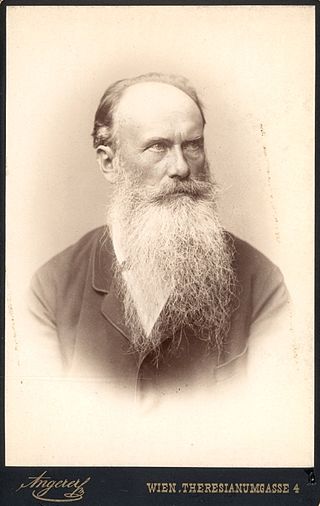
Carl Roesner (19 June 1804, Vienna - 13 July 1869, Steyr) was an Austrian architect.

Carl Roesner (19 June 1804, Vienna - 13 July 1869, Steyr) was an Austrian architect.
He studied architecture in Vienna and Rome. In 1826, he began his work as a proofreader for lectures at the Academy of Fine Arts Vienna and, in 1835, became a Professor there. He gravitated to the Romanticists and concentrated on sacred art. Wilhelm Stiassny was one of his students. He was also editor of the Allgemeine Bauzeitung (General Construction News).
As he worked during the time of the Austro-Hungarian Empire, many of his buildings are now outside Austria. A street in Vienna's Meidling district was named the "Roesnergasse" in his honor.

Meidling is the 12th district of Vienna. It is located just southwest of the central districts, south of the River Wien, west of the Gürtel belt, and east and southeast of Schönbrunn Palace. Meidling is a heavily populated urban area with many residential buildings, but also large recreational areas and parks. In sports, it is represented by the FC Dynamo Meidling. Former Chancellor of Austria Sebastian Kurz was born and raised in Meidling and his private residence is there.

Johann Lukas von Hildebrandt was an Austrian baroque architect and military engineer who designed stately buildings and churches and whose work had a profound influence on the architecture of the Habsburg Empire in the eighteenth century. After studying in Rome under Carlo Fontana, he constructed fortresses for Prince Eugene of Savoy during his Italian campaigns, becoming his favorite architect. In 1700 he became court engineer in Vienna, and in 1711 was named head of the court department of building. He became court architect in 1723. His designs for palaces, estates, gardens, churches, chapels, and villas were widely imitated, and his architectural principles spread throughout central and southeast Europe. Among his more important works are Palais Schwarzenberg, St. Peter's Church, and Belvedere in Vienna, Savoy Castle in Ráckeve, Schönborn Palace in Göllersdorf, and Schloss Hof.

Joseph Emanuel Fischer von Erlach, also Fischer von Erlach the Younger was an Austrian architect of the Baroque, Rococo, and Baroque-Neoclassical.

Philipp Jakob Straub was an Austrian sculptor from a well-known family of German Baroque sculptors. His father Johann George Straub and his brothers Johann Baptist, Joseph, and Johann Georg Straub were also sculptors, as was his nephew Franz Xaver Messerschmidt.

Johann Nepomuk Fuchs was an Austrian composer, opera conductor, teacher and editor. His editorial work included an important role in the preparation of the first complete edition of Franz Schubert's works. He was an older brother of the composer Robert Fuchs.

Friedrich von Schmidt was an architect who worked in late 19th century Vienna.

Viktor Oskar Tilgner was an Austrian sculptor and medailleur.

Eduard van der Nüll was an Austrian architect, who was one of the great masters in the historicist style of Vienna's Ringstrasse.

The Döbling Parish Church is a Roman Catholic parish church in the suburb of Oberdöbling in the 19th district of Vienna, Döbling.

Johann Nepomuk Ender was an Austrian portrait painter and engraver.

Thomas Ender was an Austrian landscape painter and watercolorist.

Hans Adam Weissenkircher was an Austrian Baroque painter and court painter of the Prince Johann Seyfried von Eggenberg in Graz.

The Church of Saints Nicholas is an early Baroque parish church located in the Güns Valley in Lockenhaus, in the Austrian state of Burgenland. It was built during the period of 1655 to 1669. Commissioned by Franz III. Nádasdy, the church was entrusted to the Augustinians and was dedicated to both St. Nicholas of Myra and St. Nicholas of Tonentino, in reference to the role of Fr. Nicholas Donellan (O.E.S.A) in Nädasdy's conversion to the Catholic faith. The parish church overlooks the town's main square.

Hieronymus Payer was an Austrian composer and pianist.

The Lichtental Parish Church is the Catholic parish church of Lichtental, now part of Vienna, Austria. Officially the Lichtentaler Pfarrkirche zu den heiligen vierzehn Nothelfern, it is dedicated to the Fourteen Holy Helpers. The church has elements of Baroque and Neoclassical architecture. It is also known as the Schubertkirche, because Franz Schubert was baptised there in 1797 and wrote several compositions for use in the church, including his first Mass for the centenary, first performed on 25 September 1814.

St. Ulrich is a Roman Catholic parish and church in Neubau, the 7th district of Vienna, Austria. The official name of the church is Pfarrkirche hl. Ulrich und Maria Trost, it is also known as Ulrichskirche. The Baroque hall church with two towers was built in 1721. It is consecrated to St. Ulrich and St. Mary.

Johann Nepomuk Schaller was an Austrian sculptor. His most famous work is a bust of Ludwig van Beethoven at age 55, created at the request of the composer's secretary Karl Holz in 1825. It was later presented to the Royal Philharmonic Society, London, on the occasion of the Beethoven Centennial.
Johann Joseph Würth, also known as Jan Josef Würth was an Austrian silversmith of the late baroque period. He is best known for the silver tomb with statues on the grave of John of Nepomuk in Prague.

Franz Bauer was an Austrian sculptor in the late Classical style.

Anton Schrödl was an Austrian painter of animals and genre scenes.